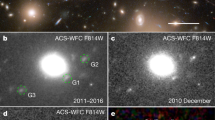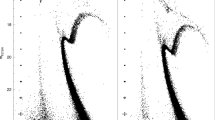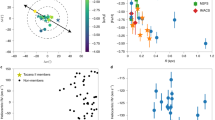Abstract
The analysis1 of gravitational microlensing events of stars2,3 in the Large Magellanic Cloud places the masses of the lensing objects in the range 0.3–0.8 solar masses, suggesting that they might be old white-dwarf stars. Such objects represent the last stage of stellar evolution: they are the cooling cores of stars that have lost their atmospheres after nuclear fusion has ceased in their centres. If white dwarfs exist in abundance in the halo of our Galaxy, this would have profound implications for our understanding of the early generations of stars in the Universe4,5,6. Previous attempts to constrain theoretically6,7,8 the contribution of white dwarfs to microlensing indicate that they can account for only a small fraction of the events. But these estimates relied on models of white-dwarf cooling that are inadequate for describing the properties of the oldest such objects. Here I present cooling models appropriate for very old white dwarfs. I find, using these models, that the widely held notion that old white dwarfs are red applies only to those with a helium atmosphere; old white dwarfs with hydrogen atmospheres, which could be a considerable fraction of the total population, will appear rather blue, with colours similar to those of the faint blue sources in the Hubble Deep Field. Observational searches for the population of microlensing objects should therefore look for faint blue objects, rather than faint red ones.
This is a preview of subscription content, access via your institution
Access options
Subscribe to this journal
Receive 51 print issues and online access
$199.00 per year
only $3.90 per issue
Buy this article
- Purchase on Springer Link
- Instant access to full article PDF
Prices may be subject to local taxes which are calculated during checkout



Similar content being viewed by others
References
Alcock, C. et al. The MACHO project Large Magellanic Cloud microlensing results from the first two years and the nature of the Galactic dark halo. Astrophys. J. 486, 697–726 (1997).
Alcock, C. et al. Possible gravitational microlensing of a star in the Large Magellanic Cloud. Nature 365, 621–623 (1993).
Aubourg, E. et al. Evidence for gravitational microlensing by dark objects in the galactic halo. Nature 365, 623–625 (1993).
Larson, R. B. Dark matter—dead stars? Comments Astrophys. 11, 273–282 (1987).
Charlot, S. & Silk, J. Signatures of white dwarf galaxy halos. Astrophys. J. 445, 124–132 (1995).
Adams, F. & Laughlin, G. Implications of white dwarf galactic halos. Astrophys. J. 468, 586–597 (1996).
Chabrier, G., Segretain, L. & Mera, D. Contribution of brown dwarfs and white dwarfs to recent microlensing observations and the halo mass budget. Astrophys. J. 468 L21–L24 (1996).
Graff, D. S., Laughlin, G. & Freese, K. MACHOs, white dwarfs and the age of the universe. Astrophys. J. 499, 7–19 (1998).
D'Antona, F. & Mazzitelli, I. Cooling of white dwarfs. Annu. Rev. Astron. Astrophys. 28, 139–181 (1990).
Bergeron, P., Saumon, D. & Wesemael, F. New model atmospheres for very cool white dwarfs with mixed H/He and pure He compositions. Astrophys. J. 443, 764–779 (1995).
Bergeron, P., Ruiz, M. T. & Leggett, S. K. The chemical evolution of cool white dwarfs and the age of the local galactic disk. Astrophys. J. Suppl. 108, 339–387 (1997).
Hansen, B. M. S. & Phinney, E. S. Stellar forensics I: cooling curves. Mon. Not. R. Astron. Soc. 294, 557–568 (1998).
Mihalas, D. Stellar Atmospheres (Freeman, San Francisco, (1970)).
Saumon, D., Bergeron, P., Lunine, J. I., Hubbard, W. B. & Burrows, A. Cool zero-metallicity stellar atmospheres. Astrophys. J. 424, 333–344 (1994).
Wood, M. A. in White Dwarfs (eds Koester, D. & Werner, K.) 41 (Springer, Heidelberg, (1995)).
Salaris, M. et al. The cooling of CO white dwarfs: influence of the internal chemical distribution. Astrophys. J. 486, 413–419 (1997).
Liebert, J., Dahn, C. D. & Monet, D. G. The luminosity function of white dwarfs. Astrophys. J. 332, 891–909 (1988).
Flynn, C., Gould, A. & Bahcall, J. N. Hubble Deep Field constraint on baryonic dark matter. Astrophys. J. 466, L55–L58 (1996).
Elson, R. A. W., Santiago, B. X. & Gilmore, G. F. Halo stars, starbursts, and distant globular clusters: A survey of unresolved objects in the Hubble Deep Field. New Astron. 1, 1–16 (1996).
Mendez, R. A., Minniti, D., de Marchi, G., Baker, A. & Couch, W. J. Starcounts in the Hubble Deep Field: constraining galactic structure models. Mon. Not. R. Astron. Soc. 283, 666–672 (1996).
Oswalt, T. D., Smith, J. A., Wood, M. A. & Hintzen, P. Alower limit of 9.5 Gyr on the age of the galactic disk from the oldest white dwarf stars. Nature 382, 692–694 (1996).
Clemens, J. C. The pulsation properties of the DA white dwarf variables. Baltic Astron. 2, 407–434 (1993).
Iben, I. A. & MacDonald, J. The effects of diffusion due to gravity and due to composition gradients on the rate of hydrogen burning in a cooling degenerate dwarf. I. The case of a thick helium buffer layer. Astrophys. J. 296, 540–553 (1985).
Paczynski, B. Evolution of single stars. VI. Model nuclei of planetary nebulae. Acta Astron. 21, 417–435 (1971).
Richer, H. B. et al. White dwarfs in globular clusters: Hubble Space Telescope observations of M4. Astrophys. J. 484, 741–760 (1997).
Bahcall, J. N., Schmidt, M. & Soneira, R. M. The galactic spheroid. Astrophys. J. 265, 730–747 (1983).
Chaboyer, B., DeMarque, P., Kernan, P. J. & Krauss, L. M. The age of globular clusters in the light of Hipparcos: resolving the age problem? Astrophys. J. 494, 96–110 (1998).
Holtzman, J. A. et al. The photometric performance & calibration of WFPC2. Publ. Astron. Soc. Pacif. 107, 1065–1093 (1995).
Acknowledgements
I thank the Aspen Center for Physics for hospitality, and M. Wood, G. Chabrier, E. Garcia-Berro and M. Hernanz for comments.
Author information
Authors and Affiliations
Corresponding author
Rights and permissions
About this article
Cite this article
Hansen, B. Old and blue white-dwarf stars as a detectable source of microlensing events. Nature 394, 860–862 (1998). https://doi.org/10.1038/29710
Received:
Accepted:
Issue Date:
DOI: https://doi.org/10.1038/29710
This article is cited by
-
Evolutionary and pulsational properties of white dwarf stars
The Astronomy and Astrophysics Review (2010)
-
Infrared spectrum of an extremely cool white-dwarf star
Nature (2000)
-
A bright future for dark matter
Nature (2000)
-
White dwarfs sing the blues
Nature (1998)
Comments
By submitting a comment you agree to abide by our Terms and Community Guidelines. If you find something abusive or that does not comply with our terms or guidelines please flag it as inappropriate.



